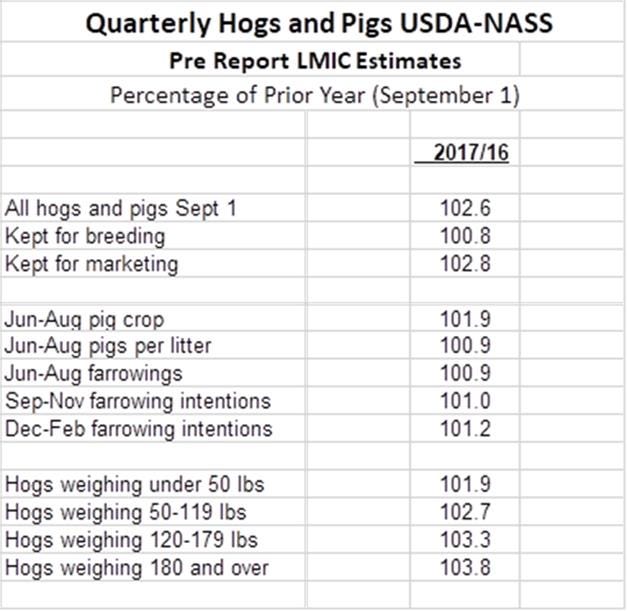The pork industry is bracing for record-breaking production. Yet, USDA sees hog prices higher than last year. Is it possible?
September 26, 2017

On Thursday afternoon the USDA releases its quarterly Hogs & Pigs report, and hog market participants are currently looking into their crystal ball. The pork industry is bracing for record production numbers in the third and fourth quarters. The USDA forecasts the third quarter at 6.3 billion pounds, 2.8% above a year earlier, and fourth-quarter production is expected to be 7 billion pounds, 5.7% above same quarter in 2016.
New packing plants are fueling the current expansion era of the U.S. swine business and the optimism. Last fall, pork producers pushed the shackle space limits, and soon the industry will put it through another stress test. Subsequently, the opening of plants in Coldwater, Mich., and Sioux City, Iowa, are so far smooth sailing, so it may not be such a balancing act as last year. The Triumph-Seaboard plant in Sioux City and the Clemens Food Group plant in Coldwater add 22,200 hogs per day. Good thing, since a new record high kill, estimated at 460,000, was reached on Sept. 25.
So days before the report, several questions come to mind.
• Will the report be bearish?
• How much expansion is actually taking place?
• How many more hogs are coming to market?
• How many additional sows were added to the U.S. hog herd?
• How accurate will the USDA numbers be?
• Can we sustain good hog prices?
Looking at the pre-report market estimates, James Robb, director at the Livestock Marketing Information Center, anticipates a 0.8% bump in the breeding herd and 2.8% increase in hogs kept for market from the previous September. Furthermore, the larger increase in hogs weighing under 50 pounds indicates the industry is not done with record-busting slaughter numbers this year.

Typically, big increases in pork supplies pressure prices lower. Yet, according to the USDA’s forecast lean hog prices are expected to average higher than a year ago at $57-58 per hundredweight in the third quarter, up 17% and $44-46 per hundredweight in the fourth quarter, almost 22% higher.
Still, the future with strong hog prices hinges on robust domestic and foreign pork demand. Sustaining hardy pork demand and good prices is a realistic concern. More hogs and more shackle space mean the additional pork needs to go somewhere. So, the entire team pork needs to sell, sell, sell.
As team pork works toward capturing more of the global market, many fundamentals threaten the U.S. pork market future.
• Next food trend: While we all know bacon never goes out of style, foodies like to switch things up. Logically, food service turned to pork bellies because it was an affordable protein. Pork belly price correction is under way. Is that signaling a shift to another food trend? Only time will tell.
• Expanding too fast: The growth in the pork industry from the farm to the processor is remarkable. Yet, the expansion is likely to take a toll on prices in 2018. If we step back and look at the big picture, how much is too much? What is the stopping point?
• Political menaces: President Donald J. Trump promised to make changes and run the country like a business. Change is messy, and the process can be complicated. Is it a good strategy to threaten withdrawal from the North American Free Trade Agreement or the U.S.-Korea Free Trade Agreement? Certainly, pulling out of those agreements is dangerous for global pork trade. As pork leaders take to the Hill, the voices need to go forth as one thoughtful strength.
The pork future is clear as mud. Depending on the latest Trump tweet, the ability to sell more pork globally may seem impossible. However, farmers and ranchers have faced unviable situations before. U.S. hog farmers, with a lot of assistance from trade organizations, have sold pork in spite of present barriers. So, even when the mission looks impossible, serve it some American bacon — something very few people can resist.
You May Also Like



